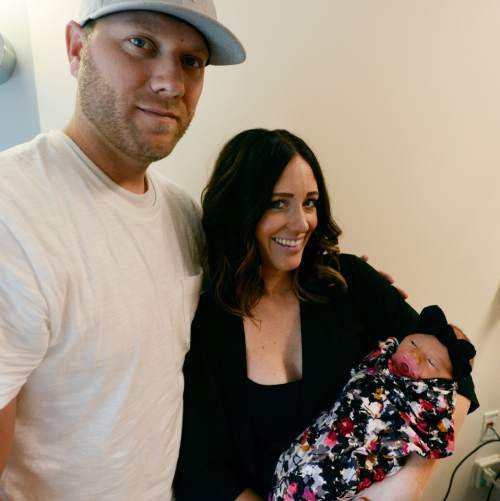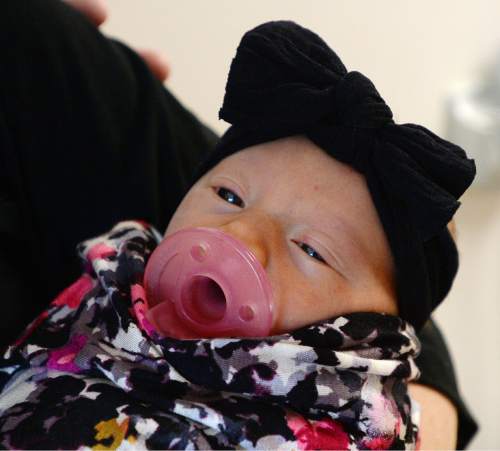This is an archived article that was published on sltrib.com in 2015, and information in the article may be outdated. It is provided only for personal research purposes and may not be reprinted.
As fireworks exploded in nearby Murray Park, Makenzie and Korey Marsh finally got their baby girl.
But as much as they welcomed the arrival of Bayne, born on the Fourth of July, it was not quite as early in their lives as the Herriman couple had hoped.
The Marshes, like hundreds of thousands of other couples throughout Utah and the United States, had delayed having children for financial reasons during the economic slump that began in 2008.
That long baby recession may finally be over.
A report from the Centers for Disease Control and Prevention shows the number of births rose nationally by 1 percent — about 53,000 babies — in 2014, the first time in six years.
Preliminary figures show Utah women also had more babies in 2014: 52,139, up from 50,913 the year before.
But Utah parents apparently shook off the financial doldrums a little earlier than the rest of the country. The state had logged other year-to-year increases from 2011 to 2012.
Bucking the downturn • Utah continues to have the nation's highest birth rate: 17.4 for every 1,000 women in their child-bearing years.
For the Marshes, the statistics make sense because they reflect their own experience.
Korey, now 32, and Makenzie, 31, had their first baby boy, Krew, in June 2008, just before the economy tanked.
At the time, Makenzie had quit her job as a medical assistant when she was put on bed rest during the pregnancy and they were relying on Korey's commission-only income.
Korey Marsh worked in real estate, leasing space for retail stores and restaurants, and few businesses were expanding.
"It just wasn't happening," he recalled. "It was too much responsibility" to take on a second child when he could not adequately support his family.
As soon as Korey had a new job as an equipment appraiser and insurance kicked in, the couple began trying to get pregnant, Makenzie Marsh said from Intermountain Medical Center, where she gave birth to 6-pound-14-ounce Bayne.
Their second son, Hoyt, was born in August 2011.
That insurance, however, had a high deductible, so the couple waited until his new job at Deseret Mutual, where their insurance carries a more manageable $4,000 out-of-pocket maximum cost, to get pregnant for a third time.
"I finally got another baby!" Makenzie said.
Lori Eining, director of Women's Services for Intermountain Healthcare's central region, said couples seem a bit more relaxed lately about the financial aspect of having babies.
It might be that the economy is better. Or it might be that more of them have insurance, because coverage is required by the Affordable Care Act, Eining said.
Nonetheless, Intermountain is predicting fairly flat birth rates at its hospitals for the next decade or so, she said.
The number of births at Intermountain Medical Center in Murray, Eining said, has inched up only about 4 percent since 2008, with 4,842 babies born there last year.
Changing trends • Pam Perlich, an economist at the University of Utah's Bureau of Economic and Business Research, sees 2014 as the "first legitimate turnaround year" for the number of new Utah babies.
"It's mostly attributable to women who deferred having children," she said. "The job market is improved enough, people are able to get a firm economic footing, and they are feeling confidence to expand and have kids."
Nonetheless, she said, Utah should have expected a drop in births even without the recession because two big groups of Utah women — those born during an early 1980s baby boom and those who immigrated here in the mid- to late 1990s — were both moving out of their prime child-bearing years.
While Utah women still generally have more children and at younger ages than their peers nationally, more of the babies are being born to older women here and elsewhere.
For instance, 20-somethings had more than 61 percent of Utah's babies in 2008, while women in their 30s had 30 percent. In 2013, women in their 20s had 56 percent of the babies, and women in their 30s had nearly 38 percent.
The median age for women marrying for the first time also rose slightly in those years.
Bob Silver, a professor of obstetrics and gynecology at the University of Utah, said that trend is seen internationally and has to do with a number of factors. Among those are that women are more often pursuing careers before families, and new reproductive technology helps more older women conceive than in earlier generations.
While the data do not show a big difference in which baby Utahns were putting off during the recession — their first or their fourth — Silver said it seemed to him it was mostly couples with no children who had jitters during the recession.
"Once people have a kid, they love that child and they have a clear idea of how many they want," Silver said. "They kind of realize they can make things work even if it's not ideal.
"It's scarier to jump in the pool in the first place."
One fact might support his theory: The percentage of Utah women jumping into the pool for the fourth, fifth, sixth or more time rose more than any other group. Those moms accounted for more than a fifth of all births in 2013, up from 18.6 percent in 2008.
Some of the data goes against conventional wisdom.
A breakdown by racial background indicated the biggest increases were among white mothers.
"It could also be that for those cases, the people already having big families, cultural considerations trump anything else," Perlich said, noting that members of the LDS Church, Hispanics and Polynesians often have large families.
And one trend is not new, but is nonetheless dramatic: The number of babies born to teens dropped dramatically from 2008 to 2013 in Utah, from 3,777 to 2,269. Teen births in the state peaked at 4,550 in 1997.
Silver said a combination of factors were probably at play: better education for teens, abstinence and more contraception.
Perlich said it's likely that parents are better about teaching their teens about contraception.
"Birth control has just become much more accessible and utilized," Perlich said.











